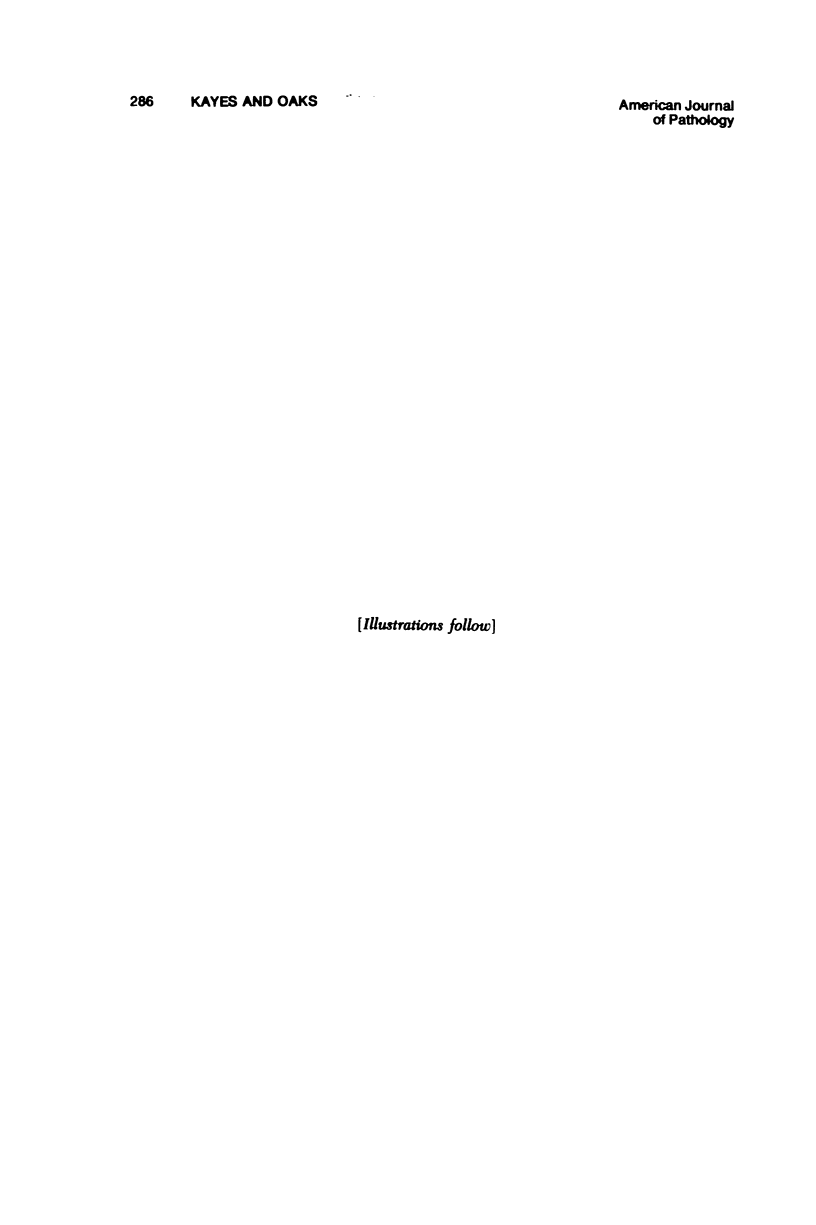Abstract
The cellular evolution of the persisting, muscle-associated granuloma in murine toxocariasis (visceral larva migrans) was chronicled for 11 weeks by light and electron microscopy. The initial granuloma consisted primarily of eosinophils and appeared to develop from the acute inflammatory infiltrate. During the ensuing 48 hours, most of the eosinophils appeared to loose their granules and disintegrate. The resulting cellular debris was then taken up by newly arrived macrophages which become the predominant mononuclear cell in the lesion by 28 days of infection. By 11 weeks, the granuloma had become a fibrotically encapsulated epithelioid granuloma surrounding the inciting larva. This histologic reaction is compared with the liver granulomatous response to Toxocara and to the well-characterized schistosome egg granuloma. A possible delayed hypersensitive etiology for the Toxocara granuloma is suggested.
Full text
PDF

















Images in this article
Selected References
These references are in PubMed. This may not be the complete list of references from this article.
- BEAVER P. C. Larva migrans. Exp Parasitol. 1956 Nov;5(6):587–621. doi: 10.1016/0014-4894(56)90032-7. [DOI] [PubMed] [Google Scholar]
- BEAVER P. C., SNYDER C. H., CARRERA G. M., DENT J. H., LAFFERTY J. W. Chronic eosinophilia due to visceral larva migrans; report of three cases. Pediatrics. 1952 Jan;9(1):7–19. [PubMed] [Google Scholar]
- BEAVER P. C. Toxocarosis (visceral larva migrans) in relation to tropical eosinophilia. Bull Soc Pathol Exot Filiales. 1962 Jul-Aug;55:555–576. [PubMed] [Google Scholar]
- BEAVER P. C. Visceral and cutaneous larva migrans. Public Health Rep. 1959 Apr;74(4):328–332. [PMC free article] [PubMed] [Google Scholar]
- Basten A., Beeson P. B. Mechanism of eosinophilia. II. Role of the lymphocyte. J Exp Med. 1970 Jun 1;131(6):1288–1305. doi: 10.1084/jem.131.6.1288. [DOI] [PMC free article] [PubMed] [Google Scholar]
- Bogitsh B. J. Schistosoma mansoni: cytochemistry of eosinophils in egg-caused early hepatic granulomas of mice. Exp Parasitol. 1971 Jun;29(3):493–500. doi: 10.1016/0014-4894(71)90058-0. [DOI] [PubMed] [Google Scholar]
- Burren C. H. Experimental toxocariasis. I. Some observations on the histopathology of the migration of Toxocara canis larvae in the mouse. Z Parasitenkd. 1968;30(2):152–161. doi: 10.1007/BF00259724. [DOI] [PubMed] [Google Scholar]
- Butterworth A. E., Sturrock R. F., Houba V., Mahmoud A. A., Sher A., Rees P. H. Eosinophils as mediators of antibody-dependent damage to schistosomula. Nature. 1975 Aug 28;256(5520):727–729. doi: 10.1038/256727a0. [DOI] [PubMed] [Google Scholar]
- Cypess R. H., Glickman L. T. Visceral larva migrans: a significant zoonosis? Mod Vet Pract. 1976 Jun;57(6):462–464. [PubMed] [Google Scholar]
- Dineen J. K., Adams D. B. The role of the recirculating thymus-dependent lymphocyte in resistance to Trichostrongylus colubriformis in the guinea-pig. Immunology. 1971 Jan;20(1):109–113. [PMC free article] [PubMed] [Google Scholar]
- Grove D. I., Mahmoud A. A., Warren K. S. Eosinophils and resistance to Trichinella spiralis. J Exp Med. 1977 Mar 1;145(3):755–759. doi: 10.1084/jem.145.3.755. [DOI] [PMC free article] [PubMed] [Google Scholar]
- James S. L., Colley D. G. Eosinophil-mediated destruction of Schistosoma mansoni eggs. J Reticuloendothel Soc. 1976 Nov;20(5):359–374. [PubMed] [Google Scholar]
- Kayes S. G., Oaks J. A. Effect of inoculum size and length of infection on the distribution of Toxocara canis larvae in the mouse. Am J Trop Med Hyg. 1976 Jul;25(4):573–580. doi: 10.4269/ajtmh.1976.25.573. [DOI] [PubMed] [Google Scholar]
- Kelly J. D., Dineen J. K. The cellular transfer to immunity to Nippostrongylus brasiliensis in inbred rats (Lewis strain). Immunology. 1972 Feb;22(2):199–210. [PMC free article] [PubMed] [Google Scholar]
- Larsh J. E., Jr Allergic inflammation as a hypothesis for the expulsion of worms from tissues: a review. Exp Parasitol. 1975 Apr;37(2):251–266. doi: 10.1016/0014-4894(75)90077-6. [DOI] [PubMed] [Google Scholar]
- Mahmoud A. A., Warren K. S., Peters P. A. A role for the eosinophil in acquired resistance to Schistosoma mansoni infection as determined by antieosinophil serum. J Exp Med. 1975 Oct 1;142(4):805–813. doi: 10.1084/jem.142.4.805. [DOI] [PMC free article] [PubMed] [Google Scholar]
- OSHIMA T. Standardization of techniques for infecting mice with Toxocara canis and observations on the normal migration routes of the larvae. J Parasitol. 1961 Aug;47:652–656. [PubMed] [Google Scholar]
- Papadimitriou J. M., Spector W. G. The origin, properties and fate of epithelioid cells. J Pathol. 1971 Nov;105(3):187–203. doi: 10.1002/path.1711050305. [DOI] [PubMed] [Google Scholar]
- Papadimitriou J. M., Spector W. G. The ultrastructure of high- and low-turnover inflammatory granulomata. J Pathol. 1972 Jan;106(1):37–43. doi: 10.1002/path.1711060104. [DOI] [PubMed] [Google Scholar]
- Phillips S. M., Colley D. G. Immunologic aspects of host responses to schistosomiasis: resistance, immunopathology, and eosinophil involvement. Prog Allergy. 1978;24:49–182. [PubMed] [Google Scholar]
- SMITH M. H., BEAVER P. C. Persistence and distribution of Toxocara larvae in the tissues of children and mice. Pediatrics. 1953 Nov;12(5):491–497. [PubMed] [Google Scholar]
- SPRENT J. F. A. On the migratory behavior of the larvae of various Ascaris species in white mice. I. Distribution of larvae in tissues. J Infect Dis. 1952 Mar-Apr;90(2):165–176. doi: 10.1093/infdis/90.2.165. [DOI] [PubMed] [Google Scholar]
- Seah S. K., Hucal G., Law C. Dogs and intestinal parasites: a public health problem. Can Med Assoc J. 1975 May 17;112(10):1191–1194. [PMC free article] [PubMed] [Google Scholar]
- Spector W. G. The dynamics of granulomas and the significance of epithelioid cells. Pathol Biol (Paris) 1975 Jun;23(6):437–439. [PubMed] [Google Scholar]
- Stenger R. J., Warren K. S., Johnson E. A. An ultrastructural study of hepatic granulomas and schistosome egg shells in murine hepatosplenic schistosomiasis mansoni. Exp Mol Pathol. 1967 Aug;7(1):116–132. doi: 10.1016/0014-4800(67)90041-x. [DOI] [PubMed] [Google Scholar]
- Warren K. S., Domingo E. O., Cowan R. B. Granuloma formation around schistosome eggs as a manifestation of delayed hypersensitivity. Am J Pathol. 1967 Nov;51(5):735–756. [PMC free article] [PubMed] [Google Scholar]
- Wong H. S., Embil J. A., Ozere R. L. Ascaris suum and Toxocara canis: egg extract antigens in guinea pigs and the macrophage migration inhibition test. Exp Parasitol. 1976 Dec;40(3):421–426. doi: 10.1016/0014-4894(76)90109-0. [DOI] [PubMed] [Google Scholar]
- Zyngier F. R., Brockbank A. Electron microscopy of the lung in experimental Toxocara canis infection. Ann Trop Med Parasitol. 1974 Jun;68(2):229–233. doi: 10.1080/00034983.1974.11686940. [DOI] [PubMed] [Google Scholar]
- Zyngier F. R. Histopathology of experimental toxocariasis in mice. Ann Trop Med Parasitol. 1974 Jun;68(2):225–228. doi: 10.1080/00034983.1974.11686939. [DOI] [PubMed] [Google Scholar]
















